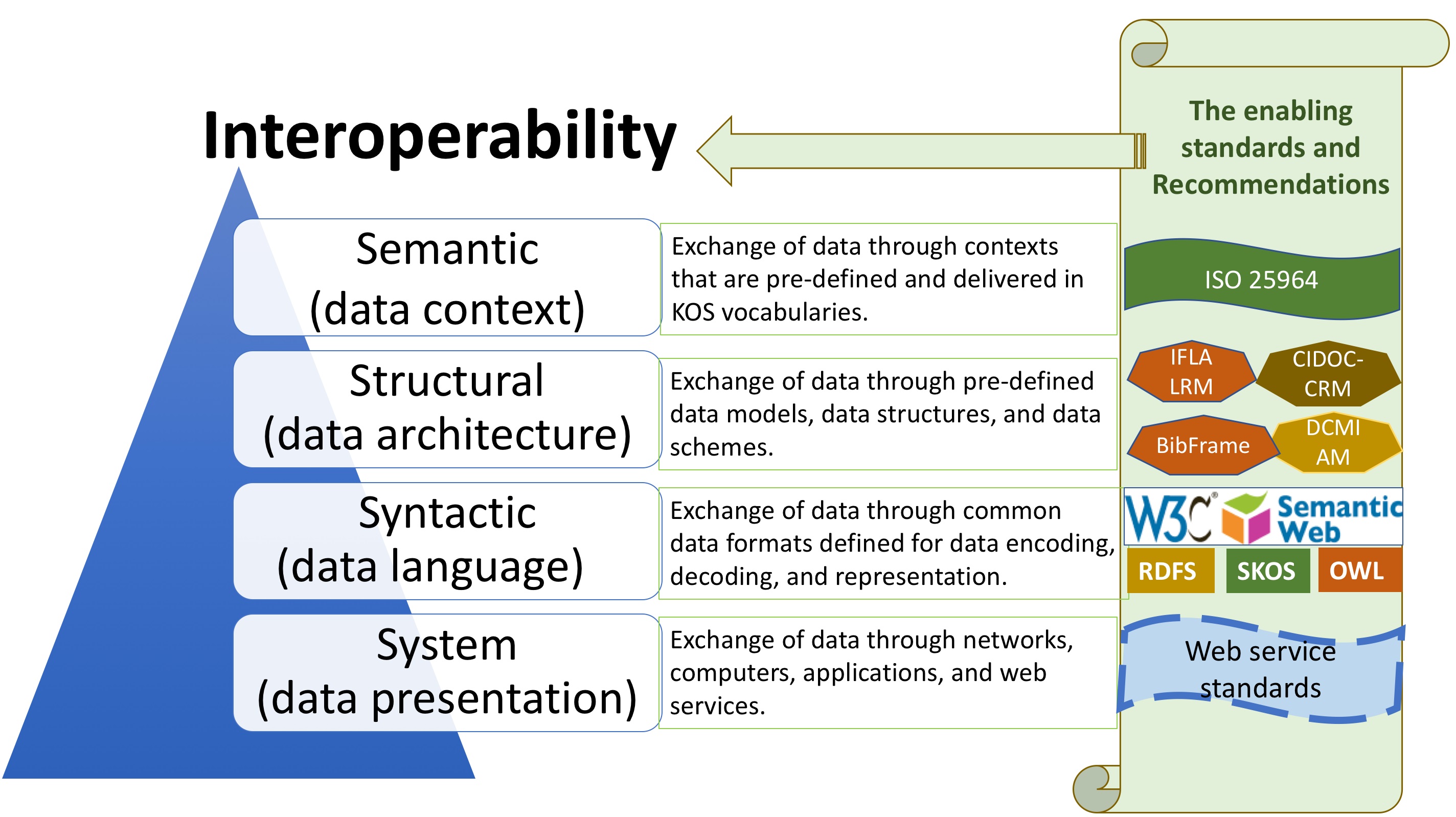KOS generation, reuse, connection, integration, and mapping
SEMANTIC INTEROPERABILITY
Notes and bookmarks
Refer to the full article: Zeng, Marcia L. "Interoperability" @ ISKO Encyclopedia of Knowledge Organization (IEKO) 2018-08-08
HOME || KOS CASES || MAPPING|| TERMINOLOGY SERVICES
WHAT
Semantic interoperability can be defined as the ability of different agents, services, and applications to communicate (in the form of transfer, exchange, transformation, mediation, migration, integration, etc.) data, information, and knowledge — while ensuring accuracy and preserving the meaning of that same data, information, and knowledge.
Semantic interoperability is situated at one of the layers of the overall interoperability pyramid in data exchanges. See Figure 1. |
 |
Standards:
1. System layer (data presentation)
Recommendations developed in the 2010s and closely connected to information providers:
- The IIIF (International Image Interoperability Framework) (https://iiif.io/api/)
- The Research Data Alliance (RDA) (https://www.rd-alliance.org/group/research-data-repository-interoperability-wg/outcomes/research-data-repository-0)
- Data on the Web Best Practices (W3C Recommendation 31 January 2017) (https://www.w3.org/TR/dwbp/)
2. Syntactic layer (data language)
W3C standards in KOS vocabularies and data exchanges:
- Resource Description Framework (RDF) (https://www.w3.org/RDF/)
- RDF Schema (RDFS) (https://www.w3.org/TR/rdf-schema/)
- Web Ontology Language (OWL)(https://www.w3.org/OWL/)
- Simple Knowledge Organization Systems (SKOS) (https://www.w3.org/2004/02/skos/)
- SKOS eXtension for Labels (SKOS-XL) (https://www.w3.org/TR/skos-reference/skos-xl.html)
3. Structural layer (data architecture)
Conceptual models established by LAM (library, archive, and museum) communities:
- IFLA LRM (Library Reference Model (https://www.ifla.org/publications/node/11412)
- DCMI Abstract Model (https://dublincore.org/documents/abstract-model/)
- BibFrame (Bibliographic Framework) (https://www.loc.gov/bibframe/)
- CIDOC-CRM (https://www.cidoc-crm.org/)
- RiC-CM (Records in Context conceptual model) (https://www.ica.org/en/egad-ric-conceptual-model)
- Linked Art Profile of CIDOC-CRM (https://linked.art/model/profile/)
4. Semantic layer (data context)
Semantic interoperability/integration is basically driven by the communication of coherent purpose.
ISO 25964. Thesauri and interoperability with other vocabularies
- Part 1: Thesauri for information retrieval.
- Part 2: Interoperability with other vocabularies
- Semantic components and relationships of each of these types are compared with thesaurus components.
(refer to ISO 25964-2:2013, Sections 17 to 24)
- Semantic components and relationships of each of these types are compared with thesaurus components.
HOW
Discover the interoperability approaches in KOS vocabulary development: KOS CASES || MAPPING||
WHERE
Find interoperable KOSs through: TERMINOLOGY SERVICES
Explore more
Refer to the full article:
Zeng, Marcia Lei. 2019. “Interoperability”. Knowledge Organization 46, no. 2: 122-146. Also available in Hjørland, Birger and Gnoli, Claudio eds. ISKO Encyclopedia of Knowledge Organization, https://www.isko.org/cyclo/interoperability
Developed by Marcia L. Zeng, 2019 for research and educational purposes. Last updated 2025-02.
![]()